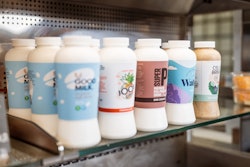
Reduce. Reuse. Recycle. It’s not just a catchy slogan; it’s actually a waste hierarchy that starts with the most preferable strategy and works its way down the list. Therefore, after reducing—or eliminating—packaging material, reuse is the next best strategy for tackling plastic packaging waste, yet it’s the one that’s used the least. According to the Ellen MacArthur Foundation, just 2% of the packaging used by its New Plastics Economy Global Commitment signatories is reusable, and that number has remained constant since the program launched in 2018.
As two recent reports illuminate, the widespread adoption of reusable packaging can result in substantial environmental benefits and is “critical to tackling the plastic waste and pollution crisis.” That’s according to EMF and Eunomia, whose 2023 report, “Unlocking a Reuse Revolution: Scaling Reusable Packaging,” outlines the challenges and opportunities to scaling up reusable systems and what’s needed for a complete system change. The second report, “Refill Again,” from non-profit ocean conservation organization Oceana, describes the scale of the plastic pollution problem and the impact reusable packaging offers.
Both reports are based on a reuse model where consumers purchase products at retail in reusable packaging that they then return to the store for subsequent sorting, cleaning, and refilling. While EMF’s report focuses on a variety of single-use plastic packaging applications, i.e., food, beverage, personal care, etc., Oceana’s centers on single-use plastic beverage cups and bottles, the latter of which, it says, is the second most common litter item across seven aquatic environments.
Although the reports differ in scope, they offer many similar conclusions. The most notable is that “returnable plastic packaging has better environmental outcomes than single-use plastic packaging across almost all scenarios, applications, and performance indicators” (EMF). Another is that recycling is a false solution to the plastic crisis. Reports Oceana, “It has been estimated that only 9% of all plastic produced since the 1950s has been recycled, with the remaining 91% incinerated, sent to landfills, or lost to the environment.”
Furthermore, Oceana says that recycling could actually be exacerbating pollution by releasing huge quantities of microplastics into wastewater. It also notes that the use of more recycled content—a goal of nearly every major CPG—does not make it more likely that a bottle will be collected and not become pollution in the ocean.
Another point made by both reports is the importance of collaboration. States EMF, “To reach the scale necessary to tackle plastic pollution, reuse urgently needs to be scaled; to make the economics work, collaboration is essential.”
One group identified as essential to this transformation is CPG brands; Oceana’s conclusions note that the beverage industry in particular holds the key to substantially reducing aquatic pollution from plastic bottles and cups. Other groups tapped as being crucial to scaling up these systems are policymakers, including state, federal, and global, who have a crucial role in creating the enabling conditions, and financial institutions, which are needed to support and invest in new infrastructure.
 “Unlocking a Reuse Revolution” from the Ellen MacArthur Foundation and Eunomia models three theoretical reuse strategies, calculates the potential of each, and provides recommendations on how to implement the most transformational strategy—system change.
“Unlocking a Reuse Revolution” from the Ellen MacArthur Foundation and Eunomia models three theoretical reuse strategies, calculates the potential of each, and provides recommendations on how to implement the most transformational strategy—system change.
If the infrastructure is put in place for a total system change, EMF estimates that moving to reuse can result in a 20%-plus reduction in annual plastic leakage to the ocean by 2040. Other environmental wins include (not surprisingly) a reduction in the use of virgin plastic, and—depending on the reuse scenario—a decrease of 35% to 69% in GHGs related to rigid-to-rigid packaging and a reduction of up to 30% to 70% in water consumption. It will also result in a significant drop in plastics volumes, up to 54% to 76%, and a decrease in waste generation of up to 90%.
Another notable finding by EMF is that even when a single-use plastic package uses 100% recycled content, reusable packaging still outperforms single-use packaging in terms of environmental impact. This excludes single-use flexible packaging, whose light weight results in lower GHGs versus reusable packaging.
 | Listen to this podcast from Packaging World editors Matt Reynolds and Anne Marie Mohan on reusable and refillable packaging. |
Oceana’s findings are similarly compelling. It reports that a 10-percentage point increase in reusable packaging by 2030 could eliminate the equivalent of over 1 trillion single-use plastic bottles and cups and prevent up to 153 billion of these containers from entering our world’s oceans and waterways.
Given the tortoise-like speed of adoption until now, reusable packaging has a long journey ahead before achieving such results. To speed this transition, in “Refill Again,” Oceana urges all beverage and bottling companies to set targets to increase reusable packaging by at least 10% and allocate appropriate involvement and marketing resources to ensure these targets are achieved.
In “Unlocking a Reuse Revolution,” EMF advises stakeholders on three concrete actions they can take to realize the full benefits of return systems. These include adopting a fundamentally new approach, kickstarting the transition by deploying collaborative multi-brand and multi-retailer systems, and following through by enlarging these systems across a greater range of products, sectors, and geographies. PW
























